Overview
Cisco Unified Border Element (CUBE) bridges voice and video connectivity between two separate VoIP networks. It is similar to a traditional voice gateway, except for the replacement of physical voice trunks with IP-based voice trunks. Traditional gateways connect VoIP networks to telephone companies using a circuit-switched connection, such as PRI. The CUBE connects VoIP networks to other VoIP networks and enterprise networks to Internet telephony service providers (ITSPs).
CUBE terminates and originates signaling Session Initiation Protocol [SIP]) and media streams (Real-Time Transport Protocol [RTP] and RTP Control Protocol [RTCP]).
 Note |
H.323 protocol is no longer supported from Cisco IOS XE Bengaluru 17.6.1a onwards. Consider using SIP for multimedia applications. |
CUBE offers a wide variety of enhanced features in addition to the conventional Session Border Controller (SBC) functions as shown in the chart below:
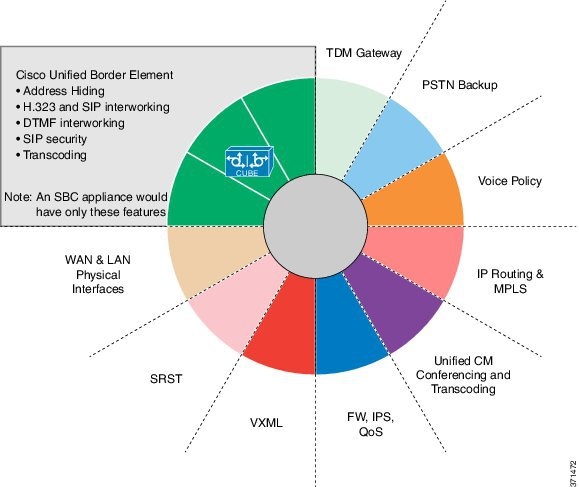
The CUBE provides a network-to-network interface point for:
-
Signaling interworking SIP.
-
Media interworking—Dual-tone multifrequency (DTMF), fax, modem, and codec transcoding.
-
Address and Port translations—Privacy and topology hiding.
-
Billing and call detail record (CDR) normalization.
-
Quality-of-service (QoS) and bandwidth management—QoS marking using differentiated services code point (DSCP) or type of service (ToS), audio quality monitoring bandwidth enforcement using Resource Reservation Protocol (RSVP), and codec filtering.
-
Media Forking—Replicate media packets for advanced media services such as call recording, transcription, and customer assist service in contact center environments.
-
Media Proxy—Proxy "forked media" session to multiple recipients for policy compliance, redundancy, and advanced media services.
-
Security Demarcation—Unencrypted signaling or media to encrypted signaling or media interworking.
-
Bridge enterprise and PSTN with cloud calling services such as Webex Calling, MS Teams Direct Routing and the like.
The CUBE provides a network-to-network demarcation interface for signaling interworking, media interworking, address and Port translations, billing, security, quality of service, call admission control, and bandwidth management.
The CUBE is used by enterprise and small and medium-sized organizations to interconnect SIP PSTN access with on-premise enterprise and hosted unified communications networks.
A CUBE interoperates with several different network elements including voice gateways, IP phones, and call-control servers in many different application environments, from advanced enterprise voice and video services with Cisco Unified Communications Manager or Cisco Unified Communications Manager Express, as well as simpler toll bypass and VoIP (VoIP) transport applications. The CUBE provides organizations with all the border controller functions integrated into the network layer to interconnect unified communications voice and video enterprise-to-service-provider architectures.
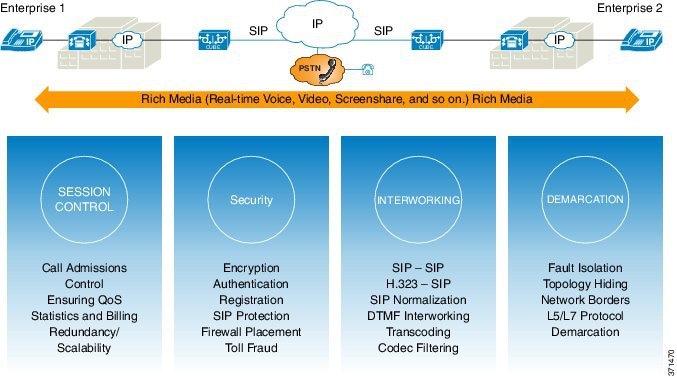
If enterprise subscribes to VoIP services offered by an ITSP, connecting the enterprise Cisco Unified Communications Manager through a CUBE provides network demarcation capabilities, such as security, topology hiding, transcoding, Call Admission Control, protocol normalization and SIP registration, none of which is possible if Cisco Unified Communications Manager connects directly to the ITSP. Another use case involves mergers or acquisitions in enterprise and the need to integrate voice equipment, such as CUCMs, IP PBXs, VM servers, and so on. If the networks in the two organizations have overlapping IP addresses, CUBE connects the two distinct networks until the acquired organization is migrated into the enterprise addressing plan.
SIP Trunking
The Session Initiation Protocol (SIP) is a signaling communications protocol, multimedia communication sessions such as voice and video calls over Internet Protocol (IP) networks. SIP trunking is the use of VoIP to facilitate the connection of Private Branch Exchange (PBX) to other VoIP endpoints across the Internet. To use SIP trunking, an enterprise must have a PBX (internal VoIP system) that connects to all internal end users, an Internet Telephony Service Provider (ITSP), and a gateway that serves as the interface between the PBX and the ITSP. One of the most significant advantages of SIP trunking is the ability to combine data, voice, and video in a single line, eliminating the need for separate physical media for each mode.

SIP trunking overcomes TDM barriers, in that it:
-
Improves efficiency of interconnection between networks
-
Simplifies PSTN interconnection with IP end-to-end
-
Enables rich media services to employees, customers, and partners
-
Carries converged voice, video, and data traffic

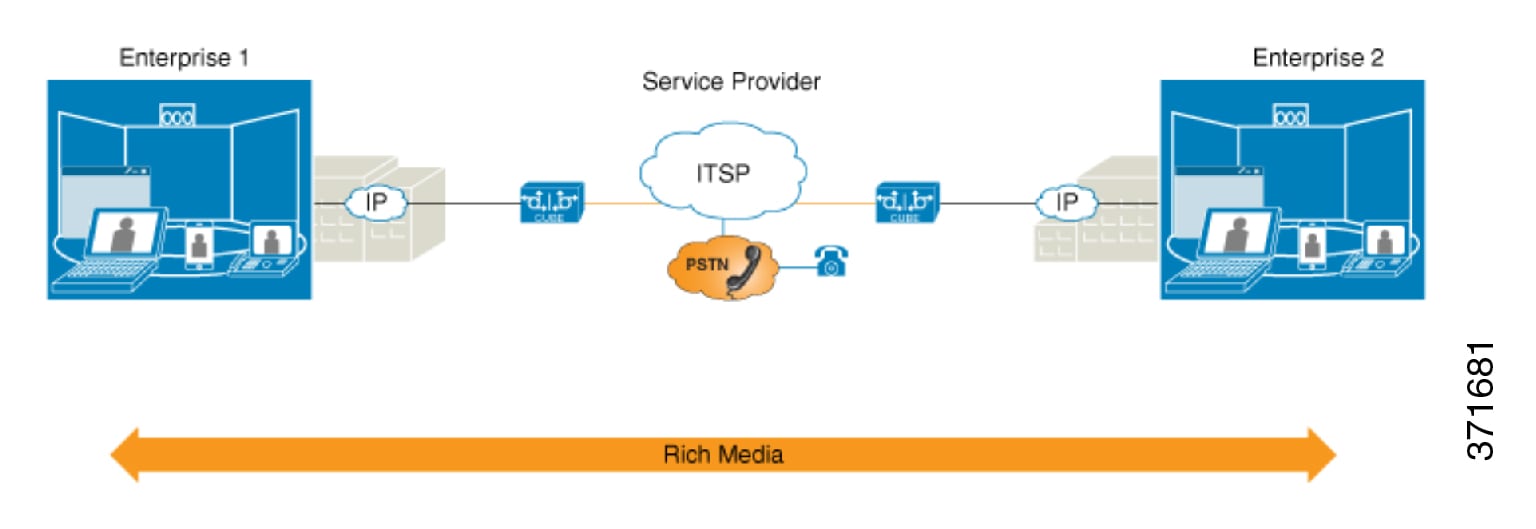
 Note |
For Cisco IOS XE Gibraltar 16.11.1a and later releases, configure the either of the following CLIs to initiate the SIP processes:
In the releases before Cisco IOS XE Gibraltar 16.11.1a, configure the following commands to initiate the SIP processes:
|
Deployment Scenarios
CUBE in an enterprise environment that serves:
-
PSTN Access: Connect on-prem enterprise voice and hosted UC network via SIP trunks for PSTN calling services
-
Contact Center Integration: Integration with contact center software components to provide inbound calling, outbound dialing,call queuing, IVR streaming, agent transfer, and advanced media forking services.
-
Webex Audio Edge: Connect on-prem enterprise/PSTN to Webex Meetings (audio dial-in/dial-out).
-
Media Proxy/Forking
-
Business-to-Business Telepresence
-
Line side Registration Proxy
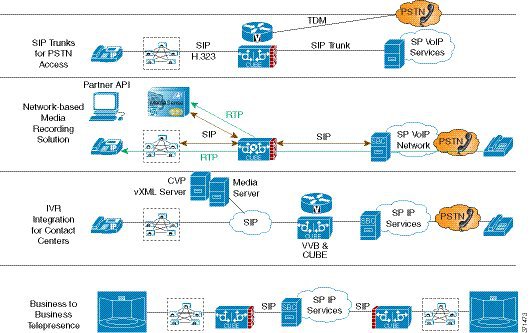
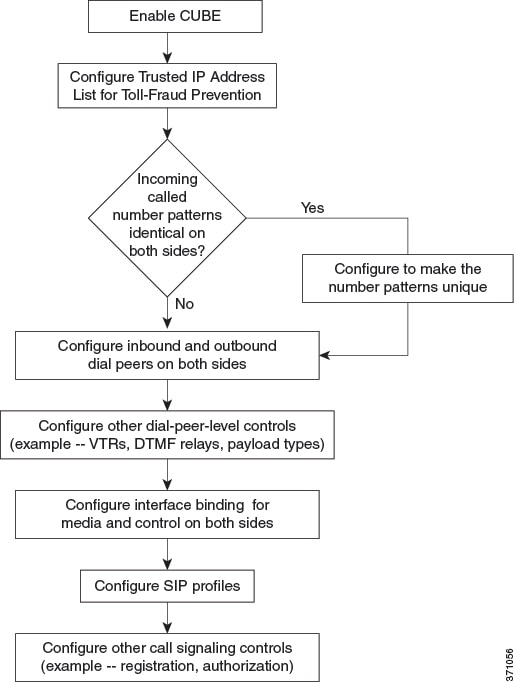
 Feedback
Feedback